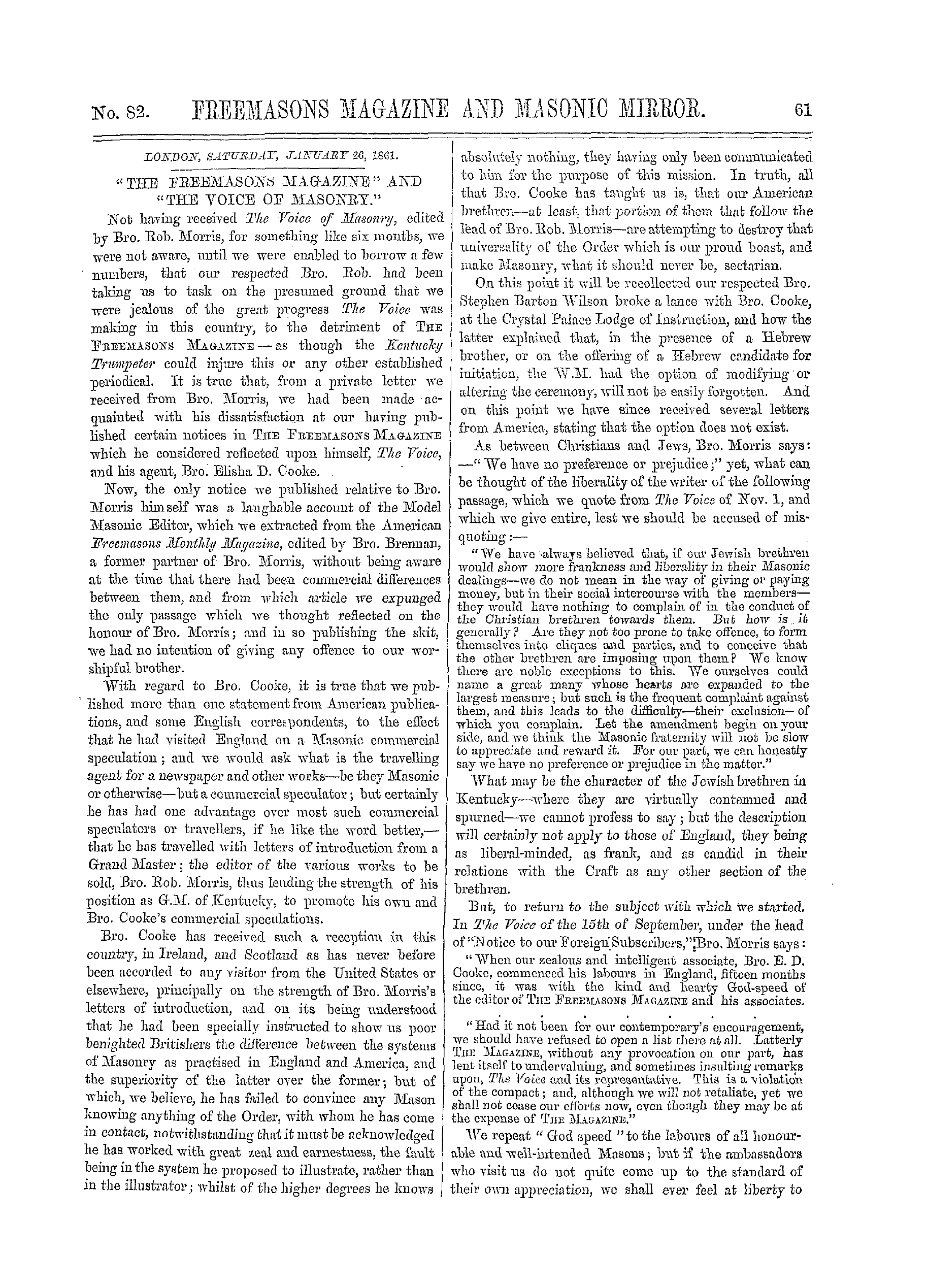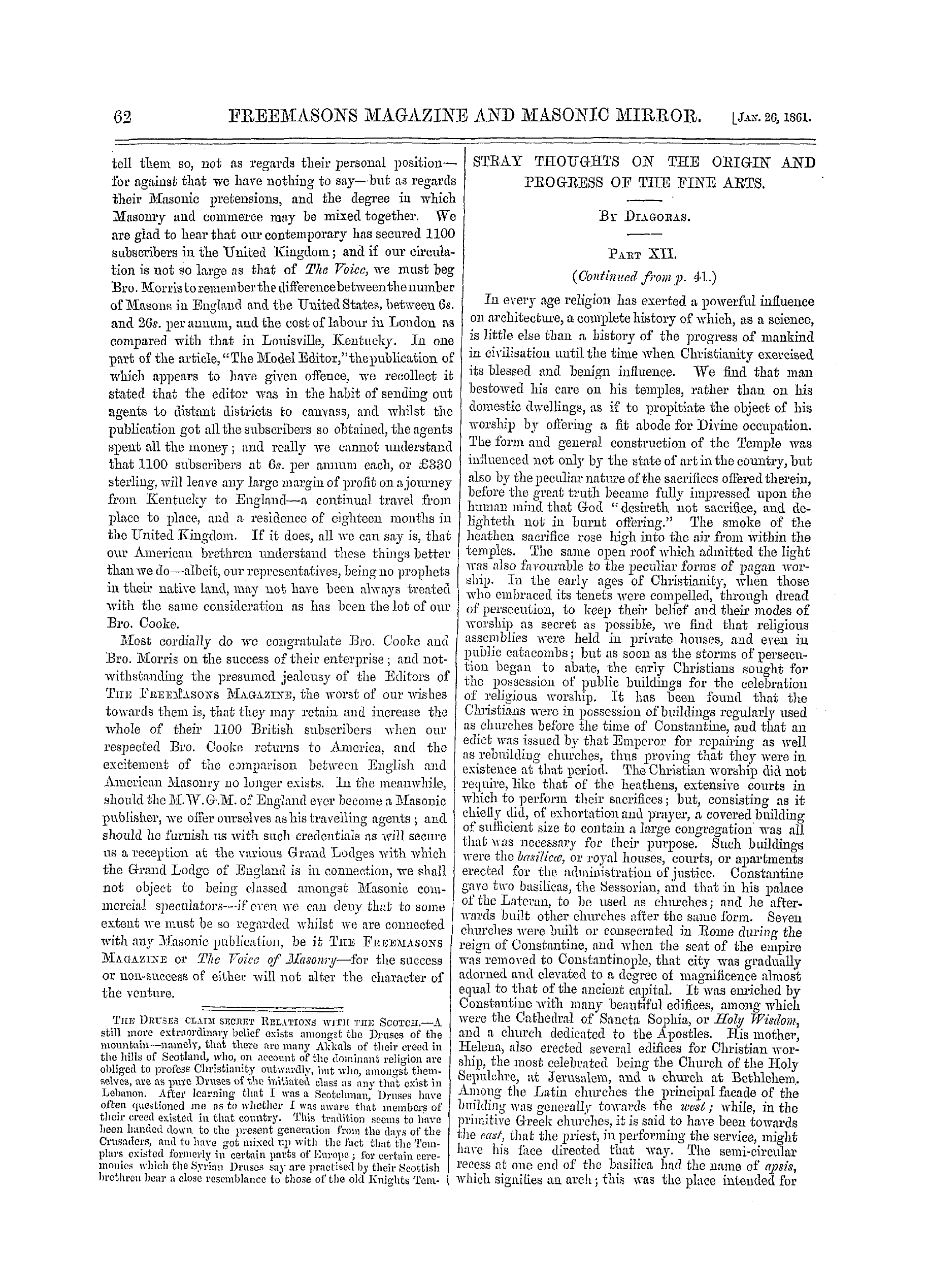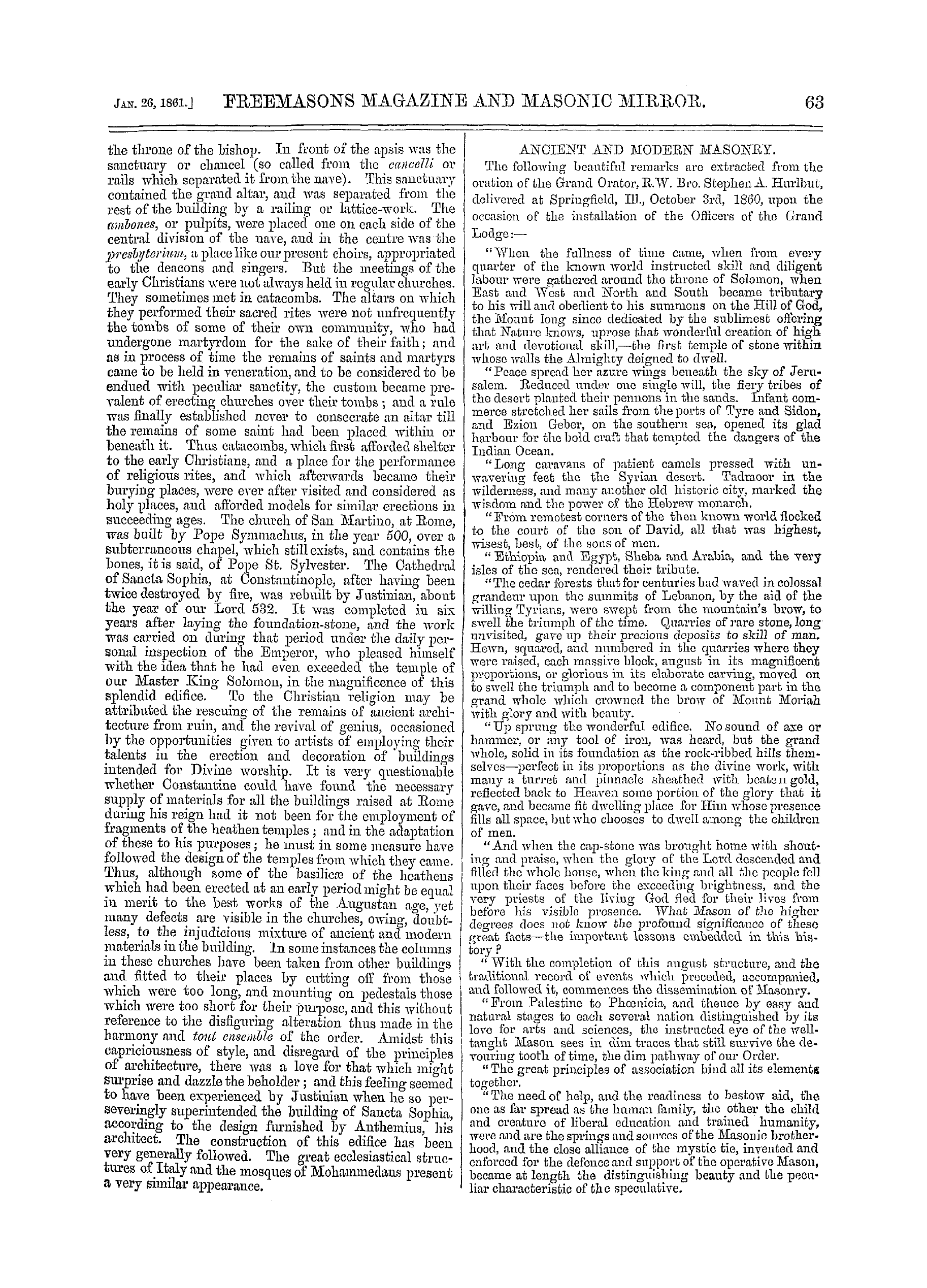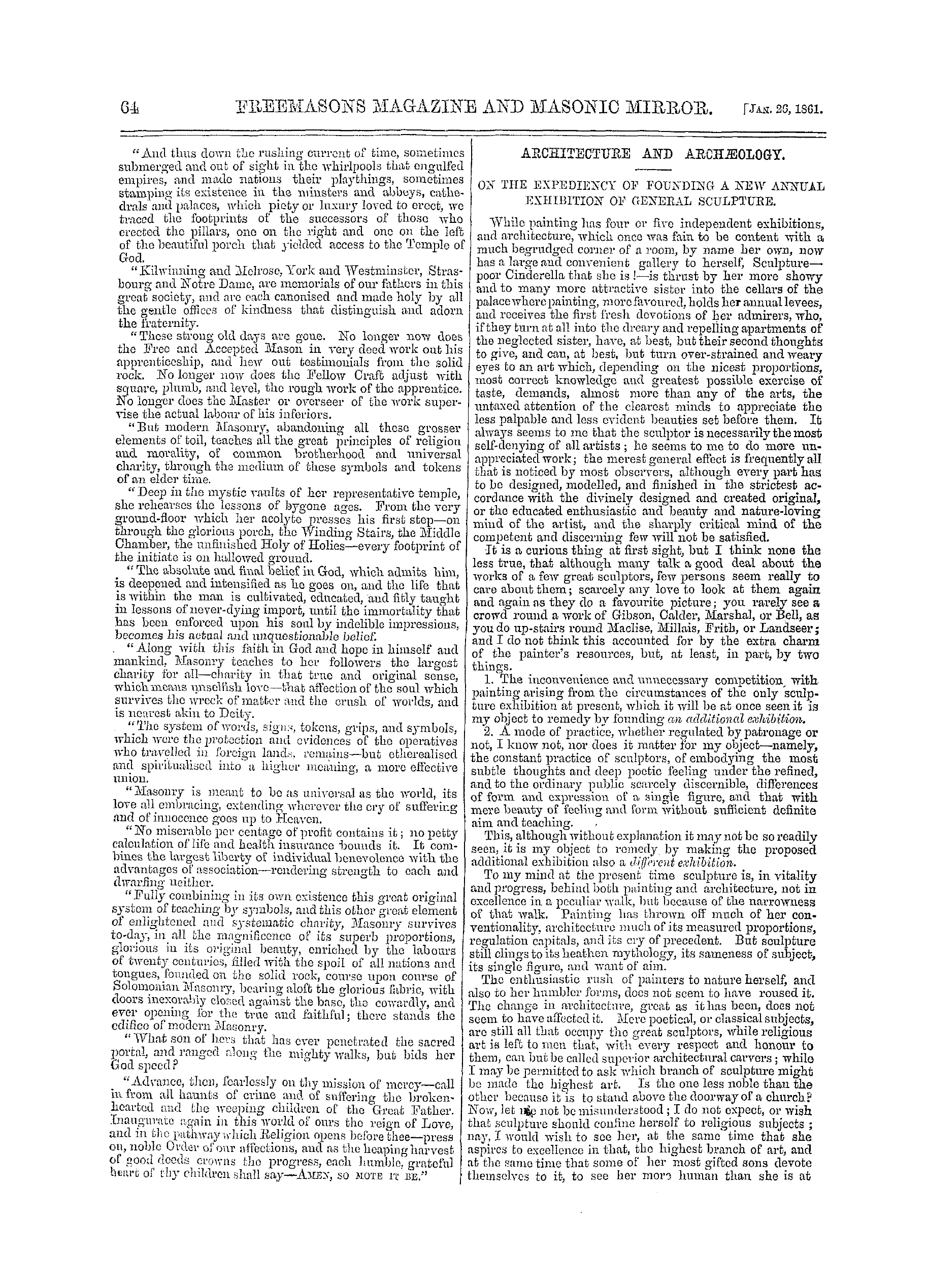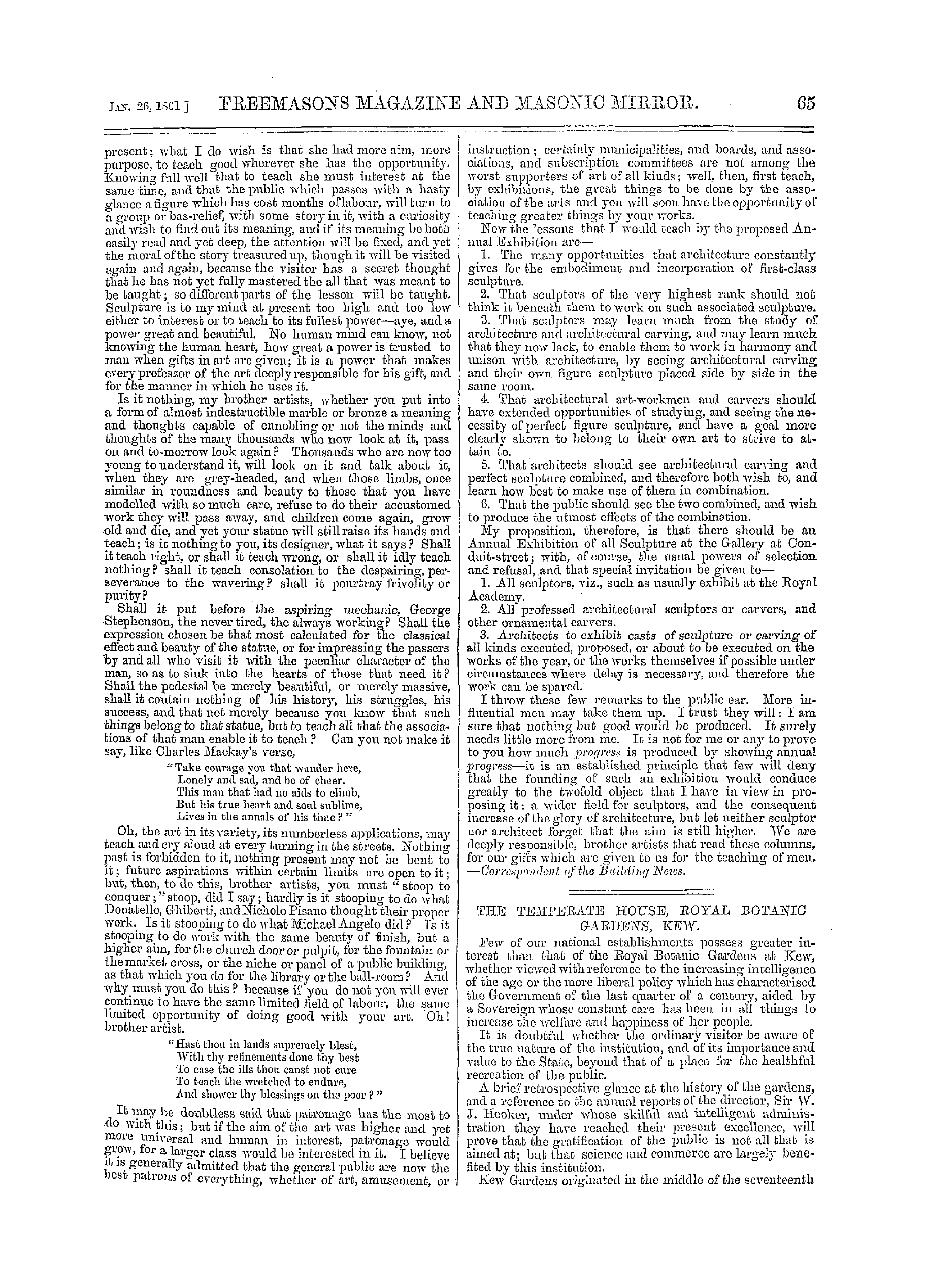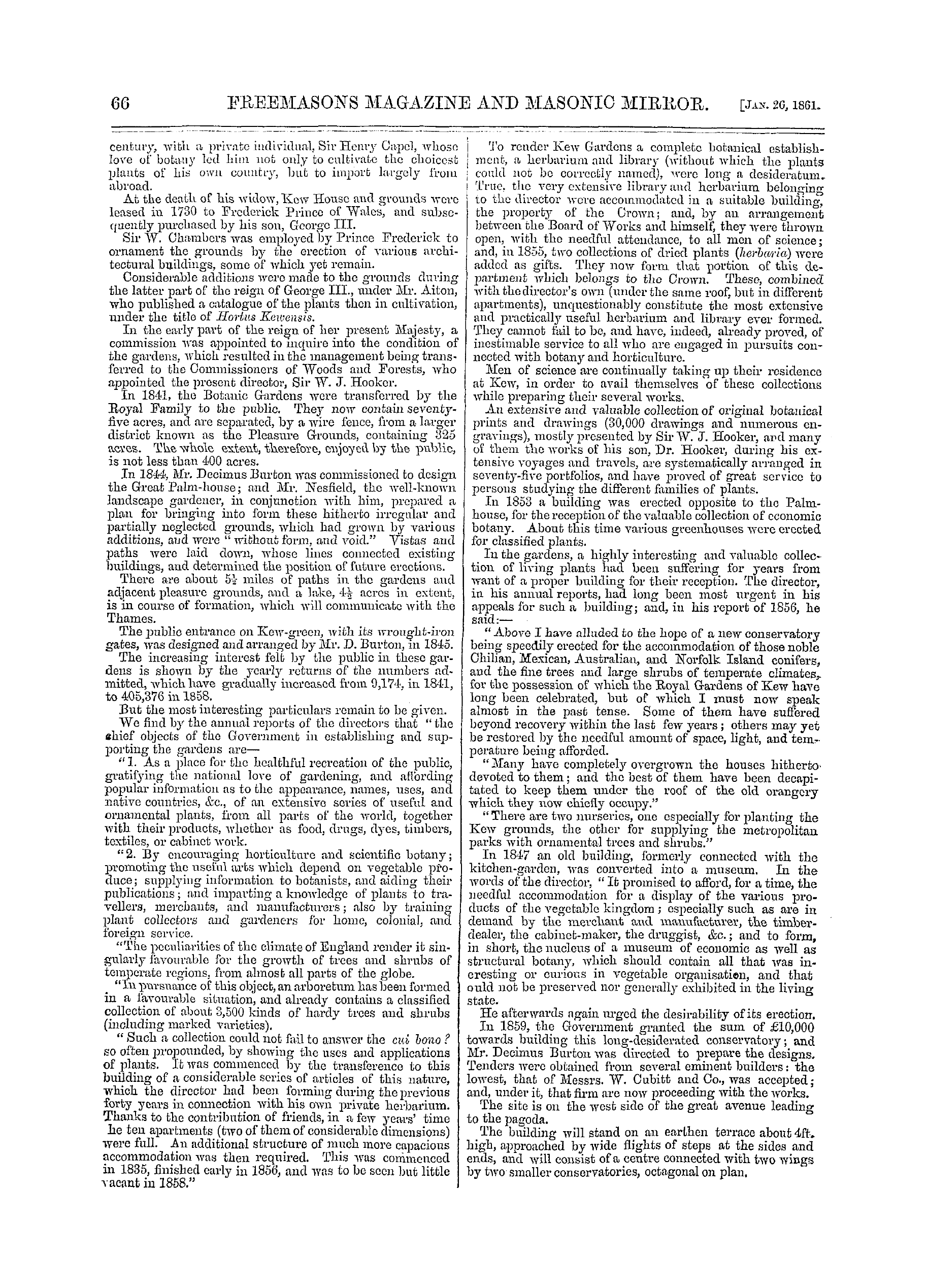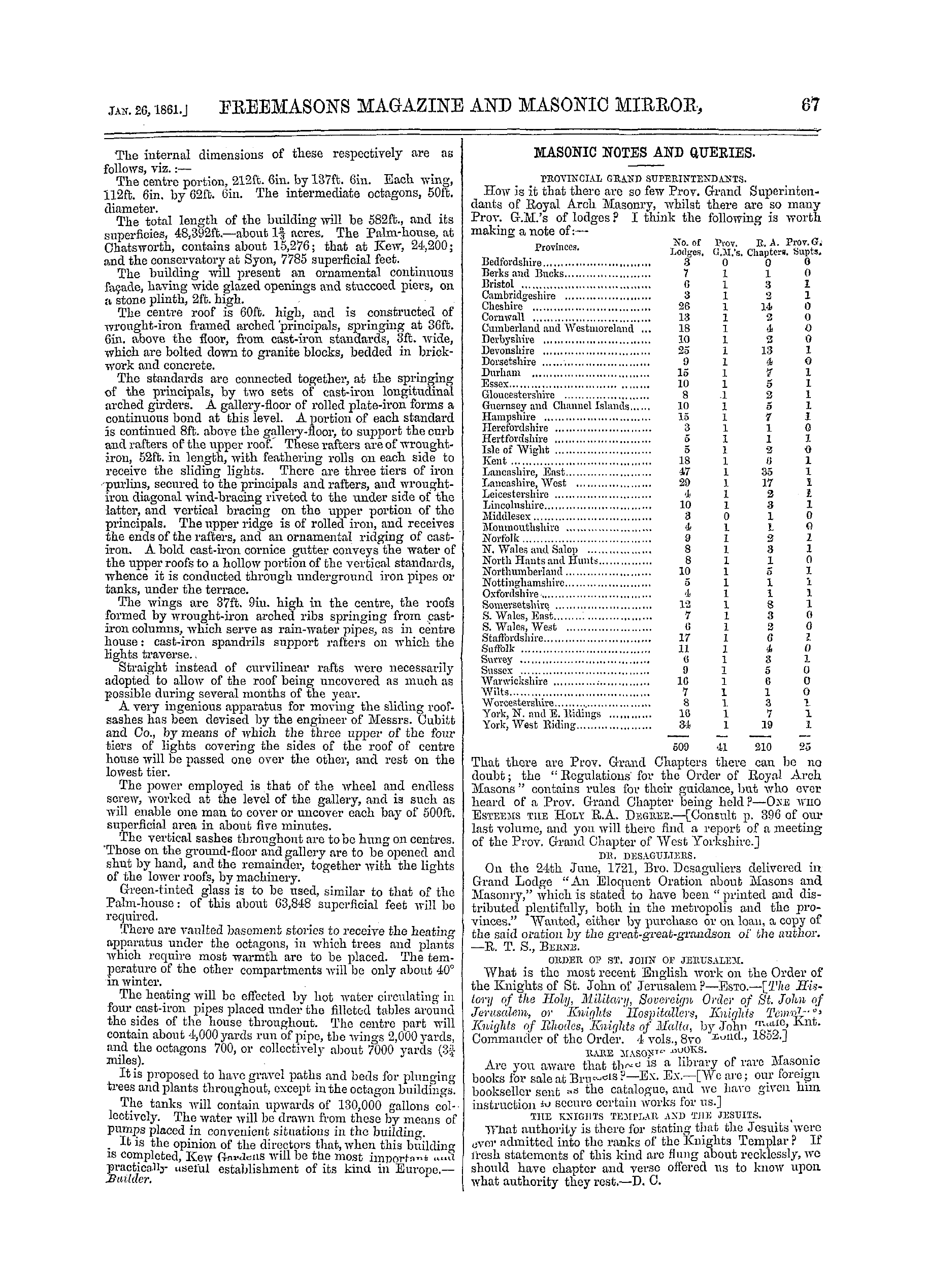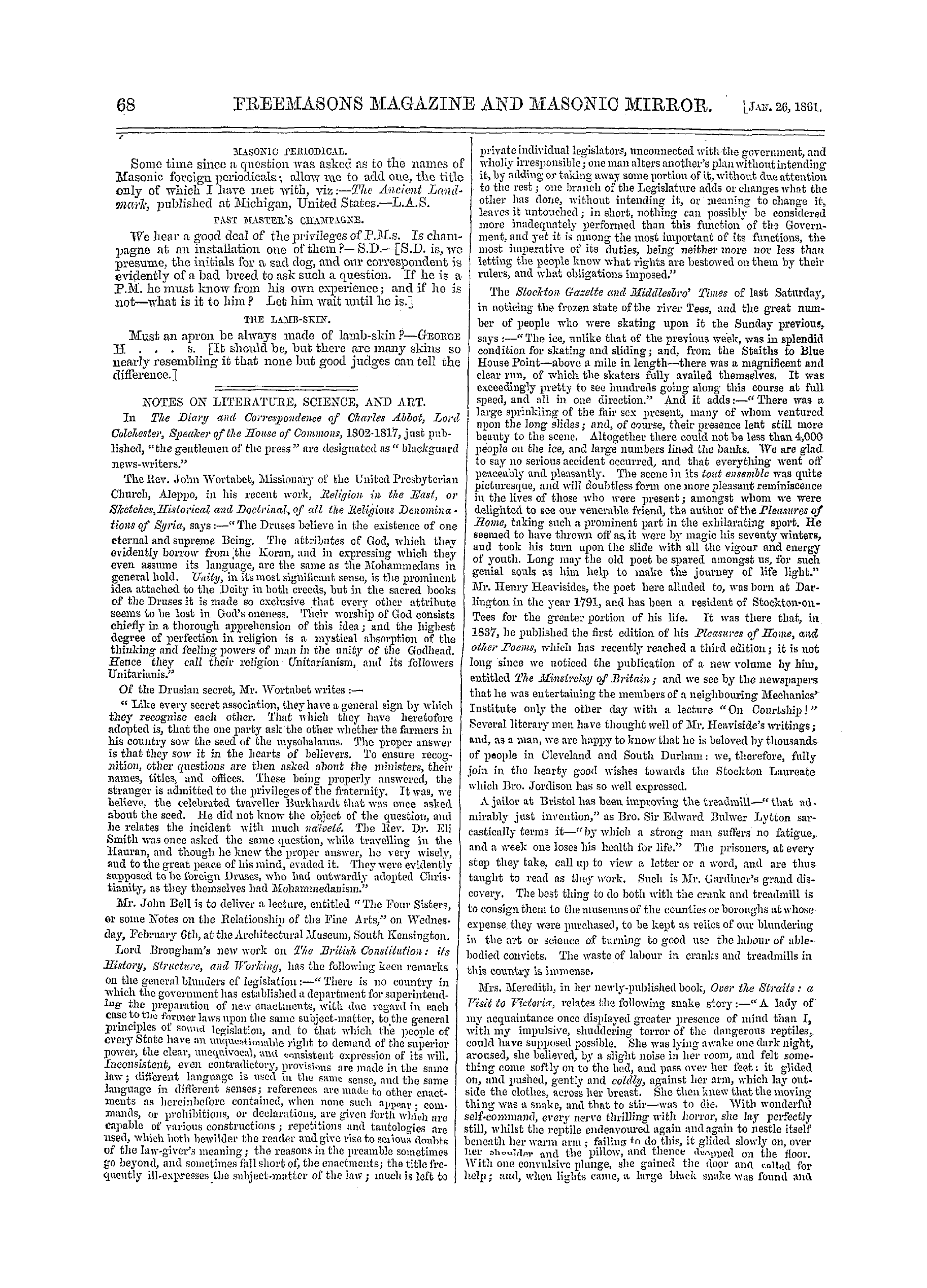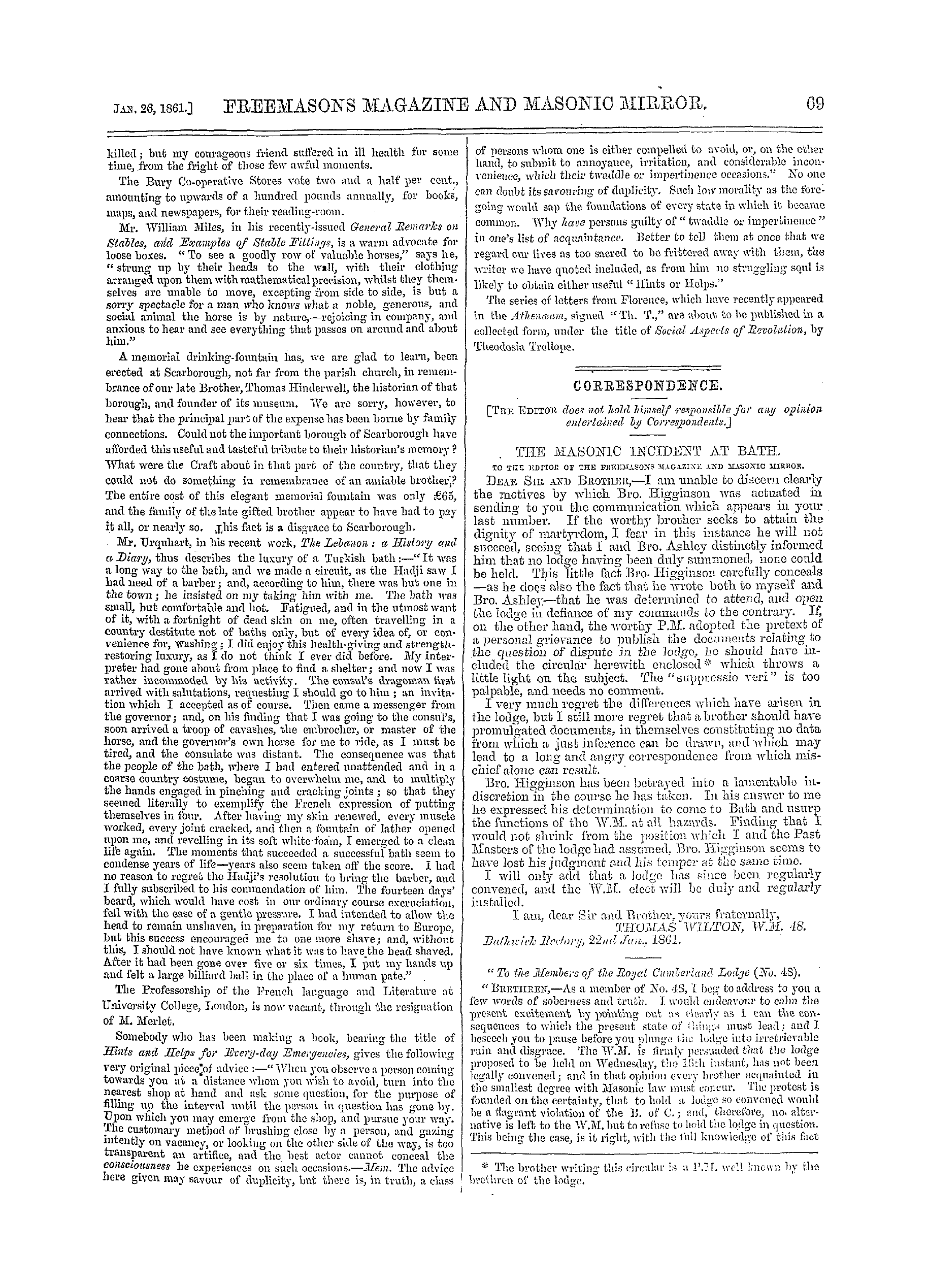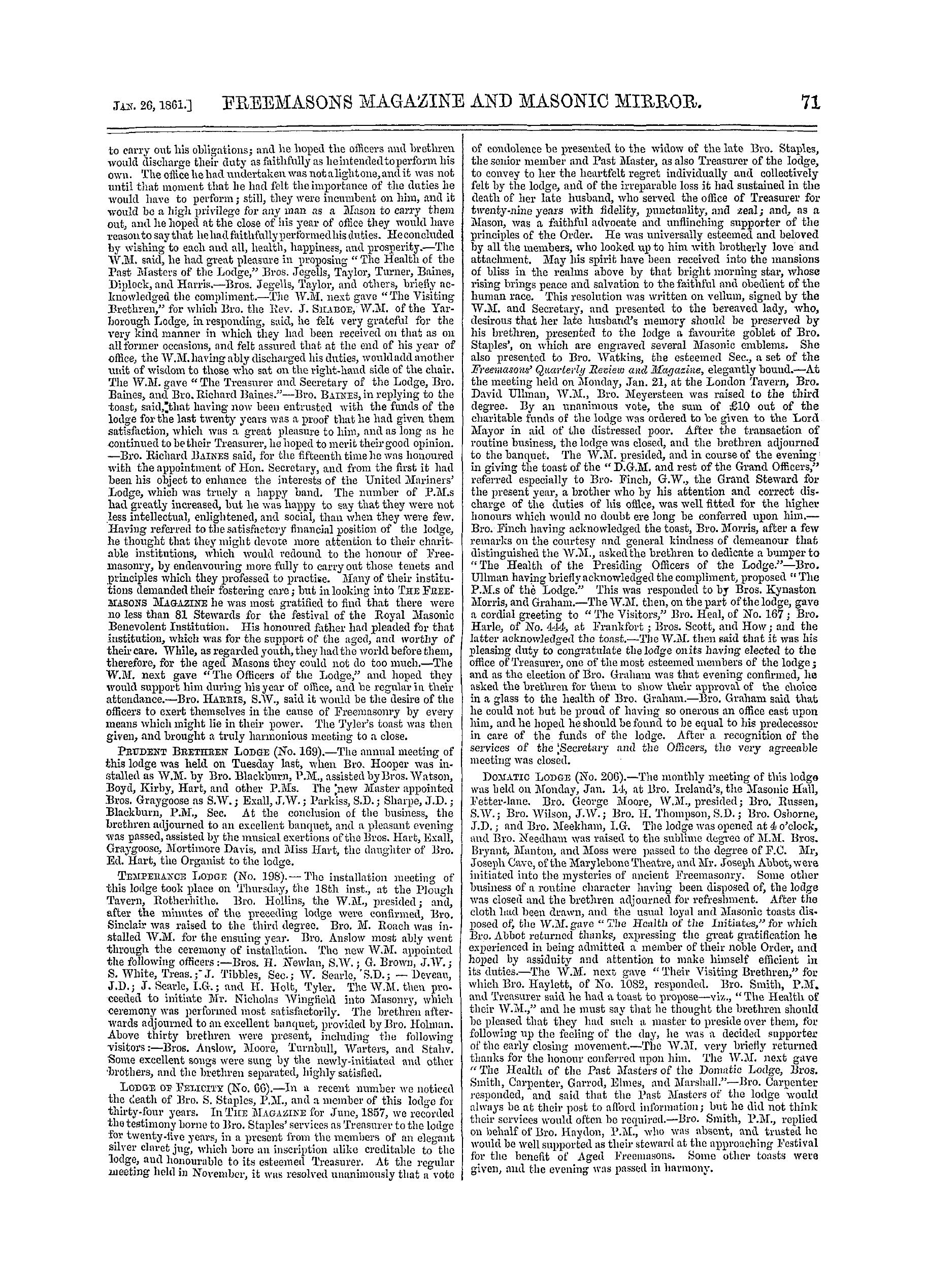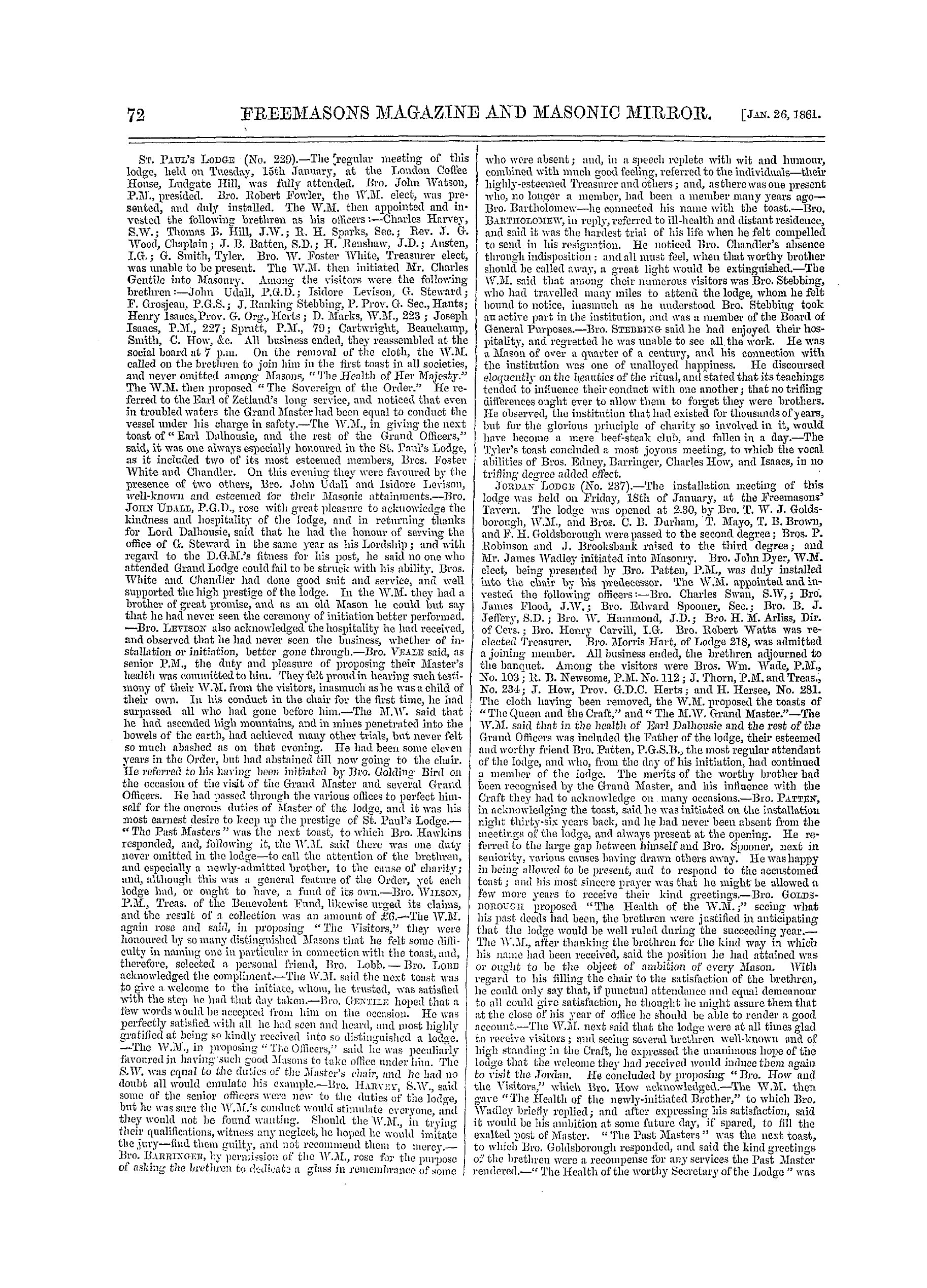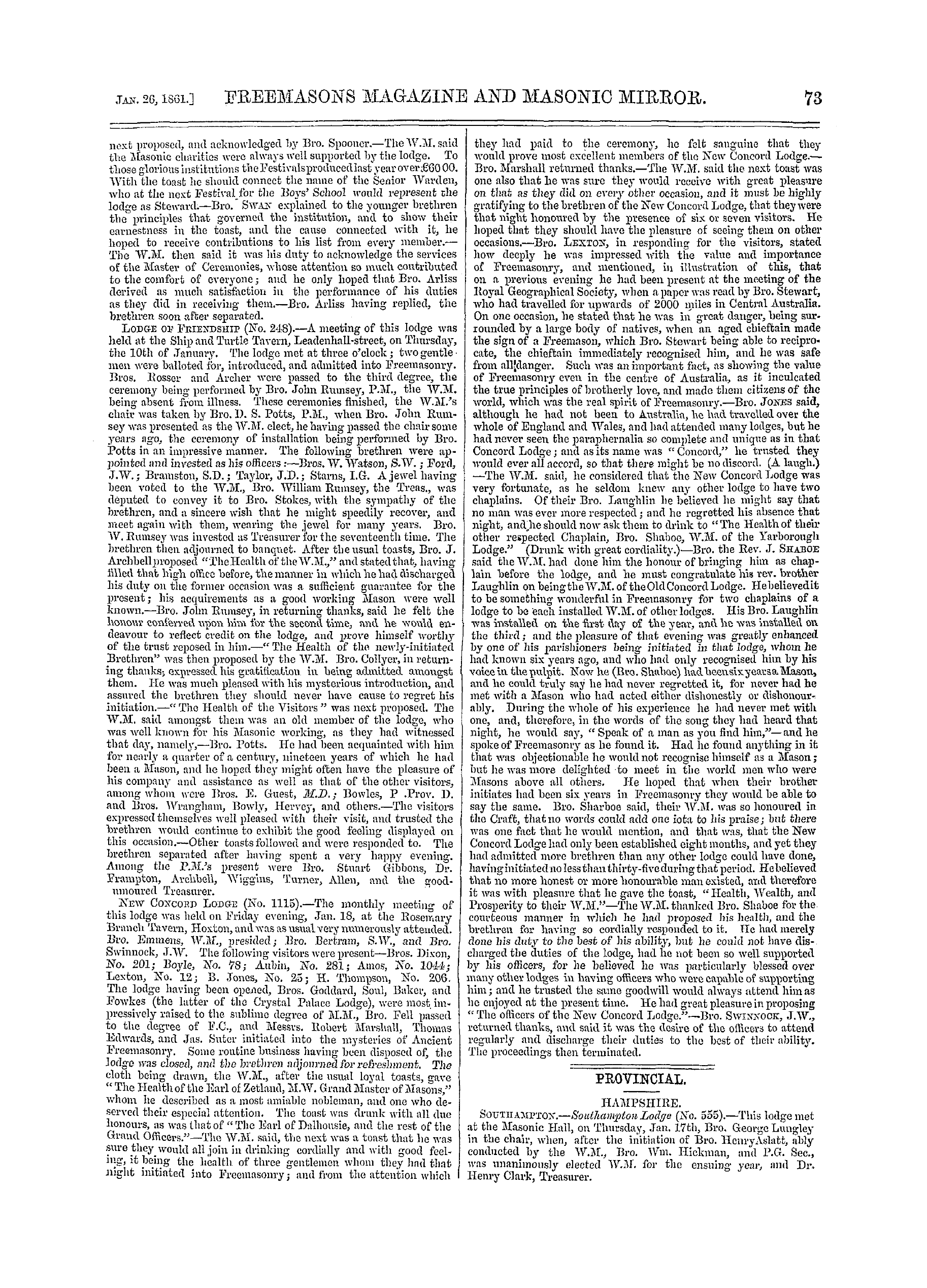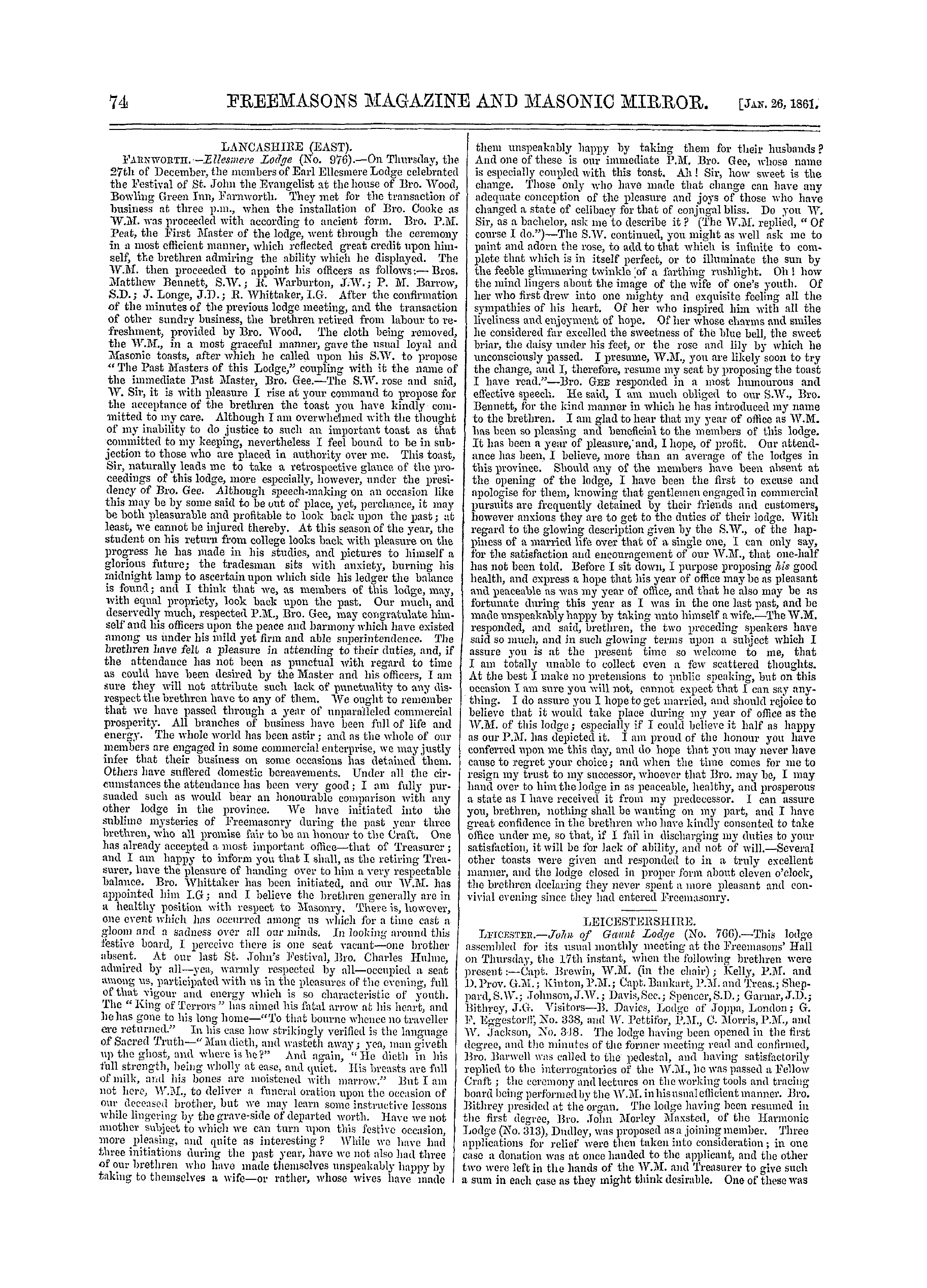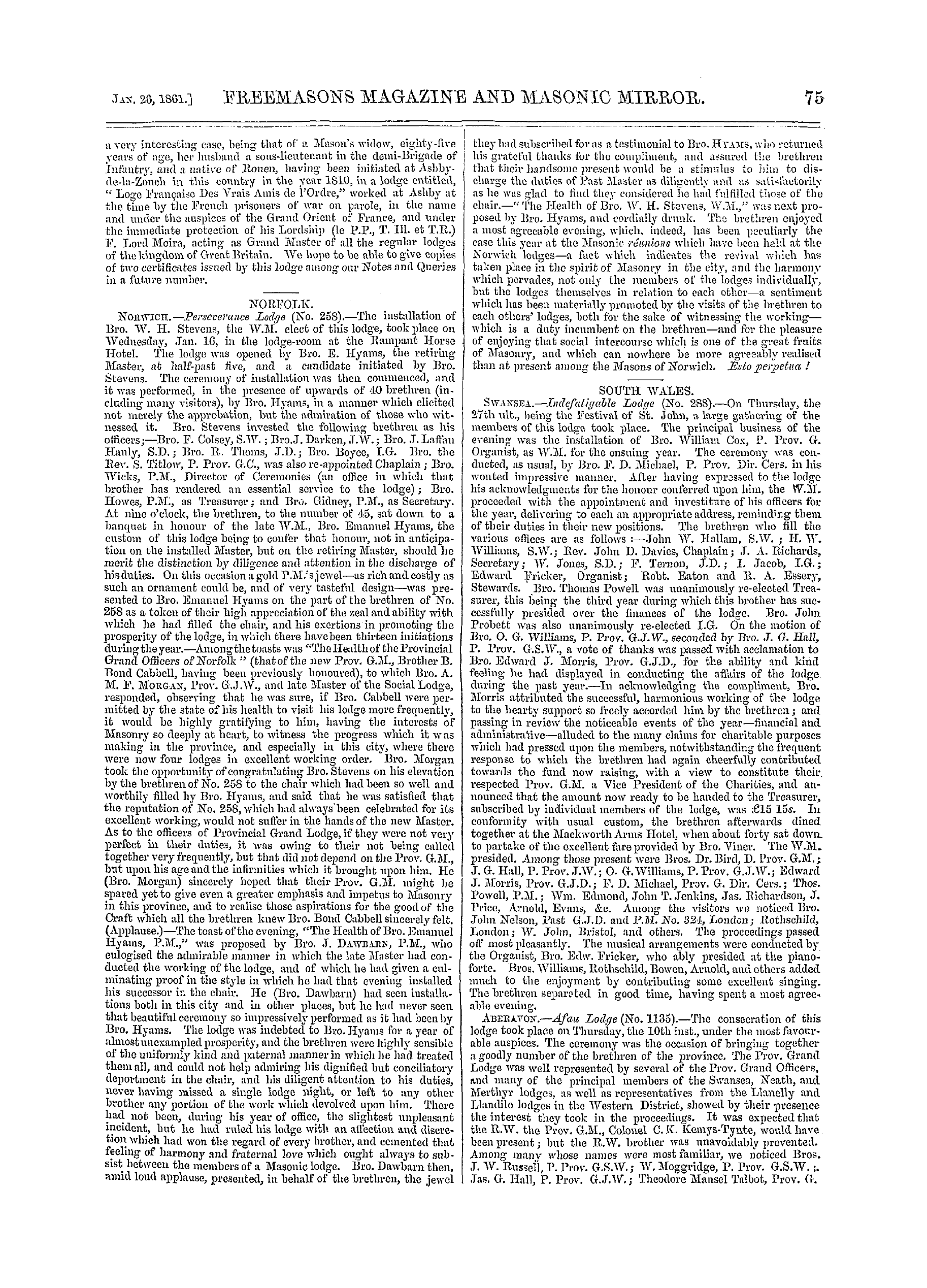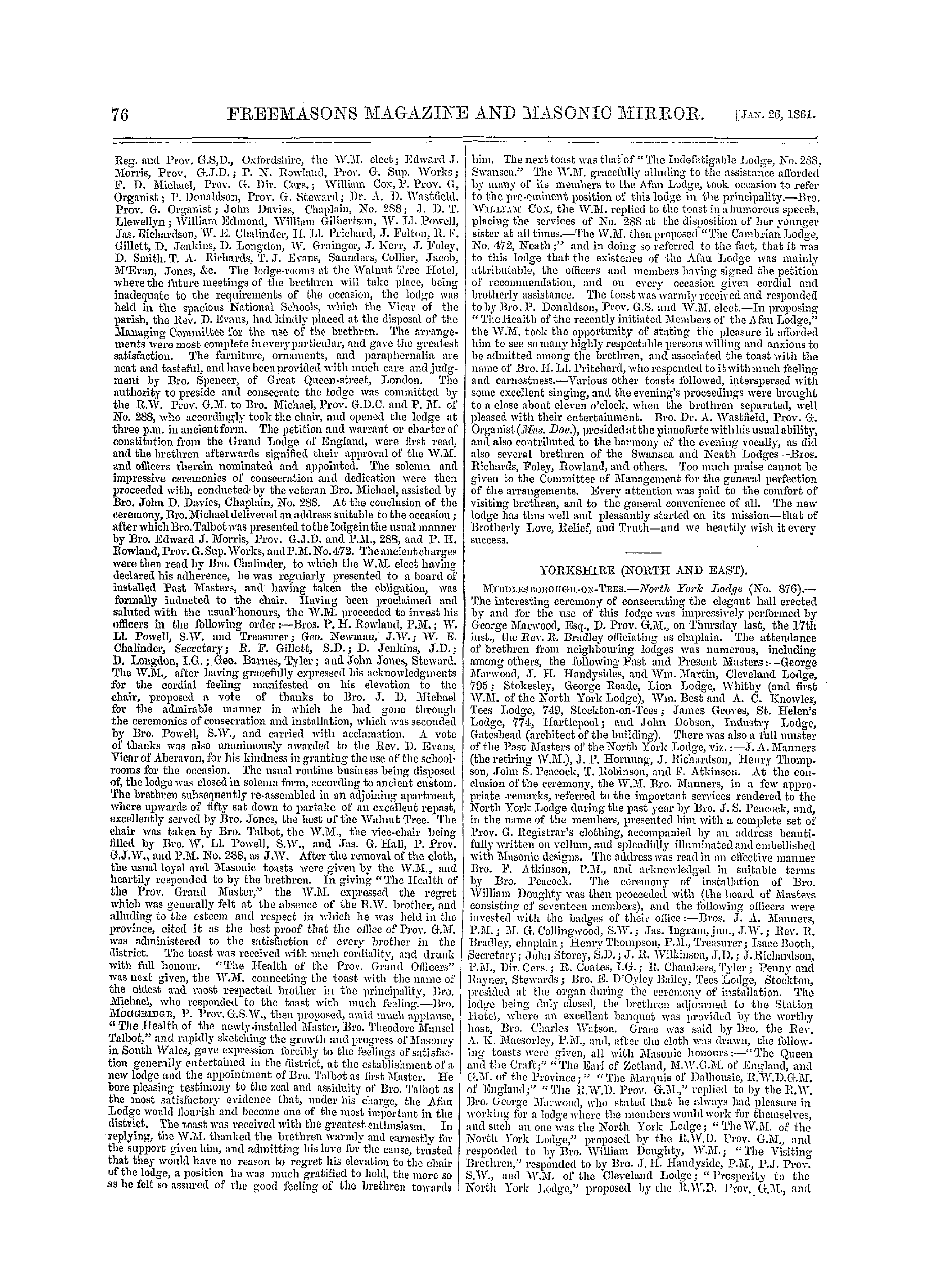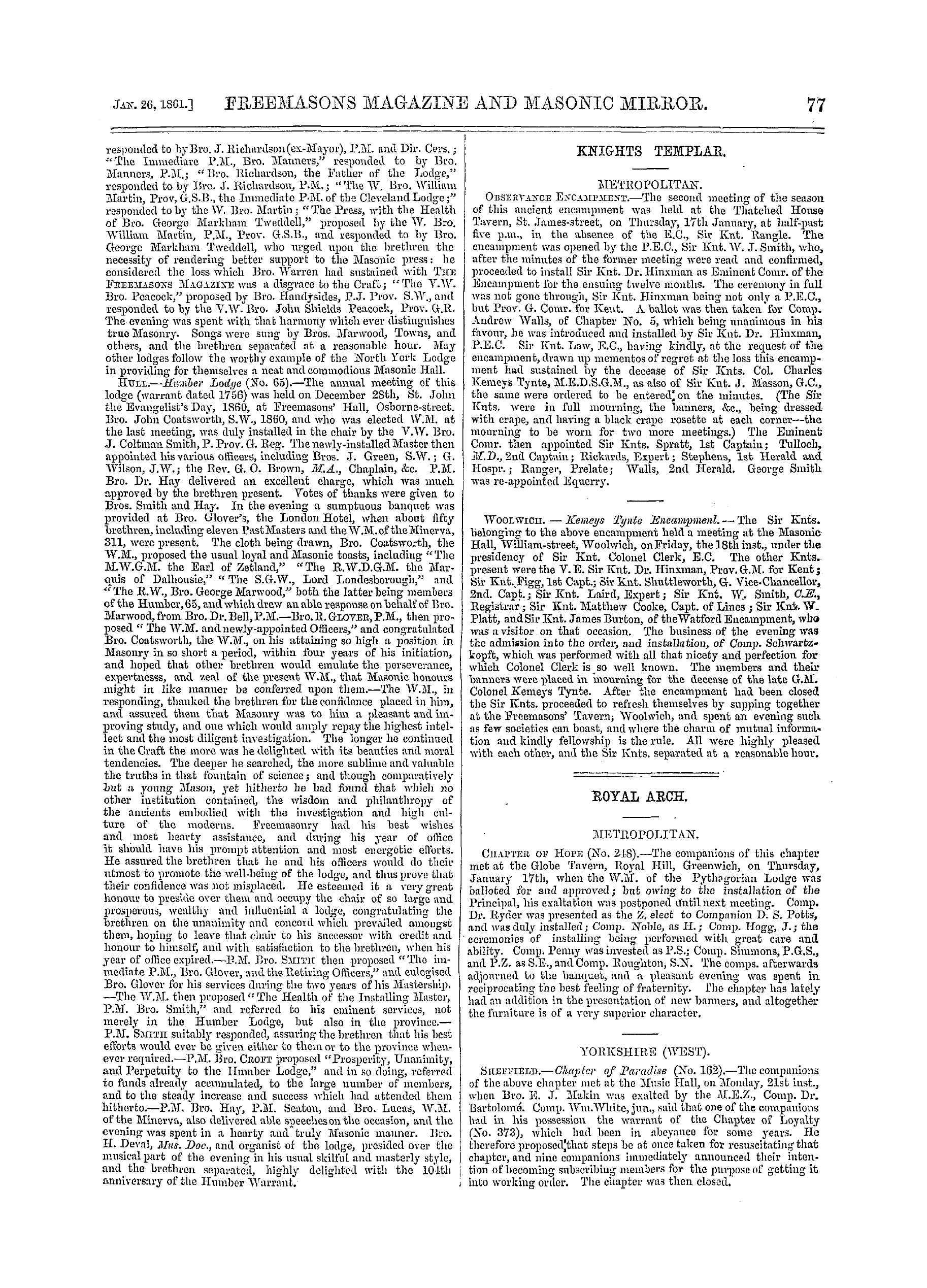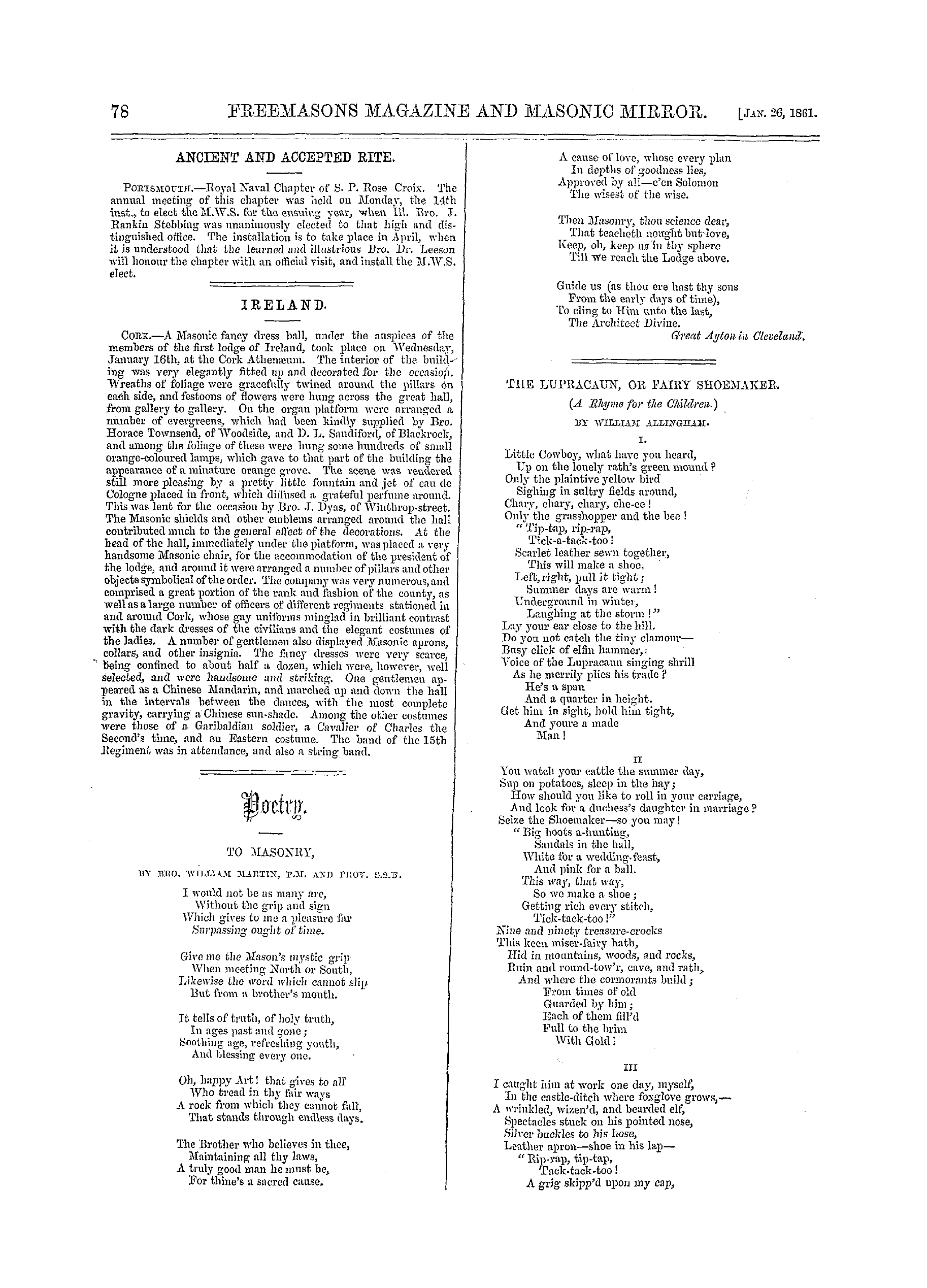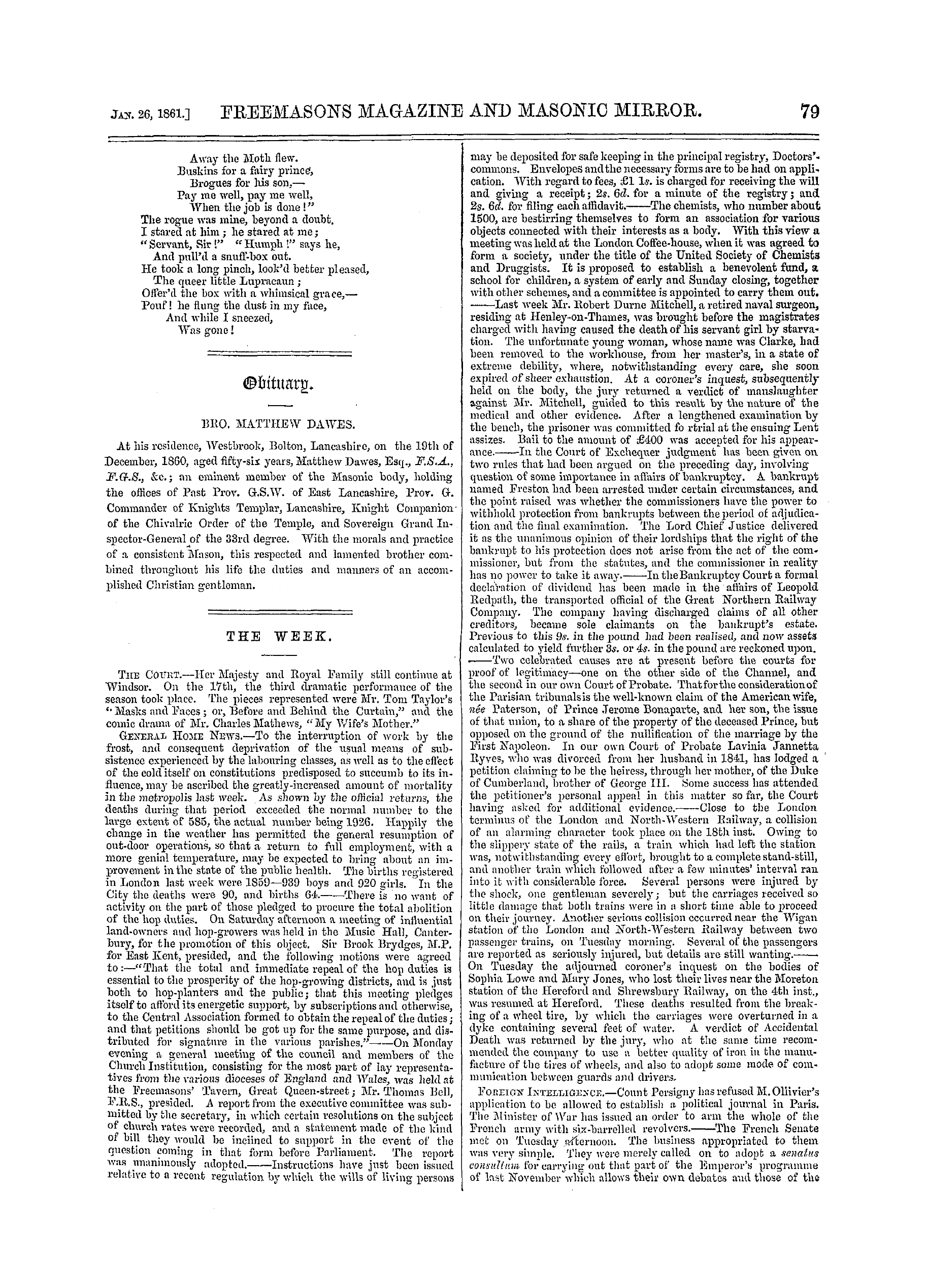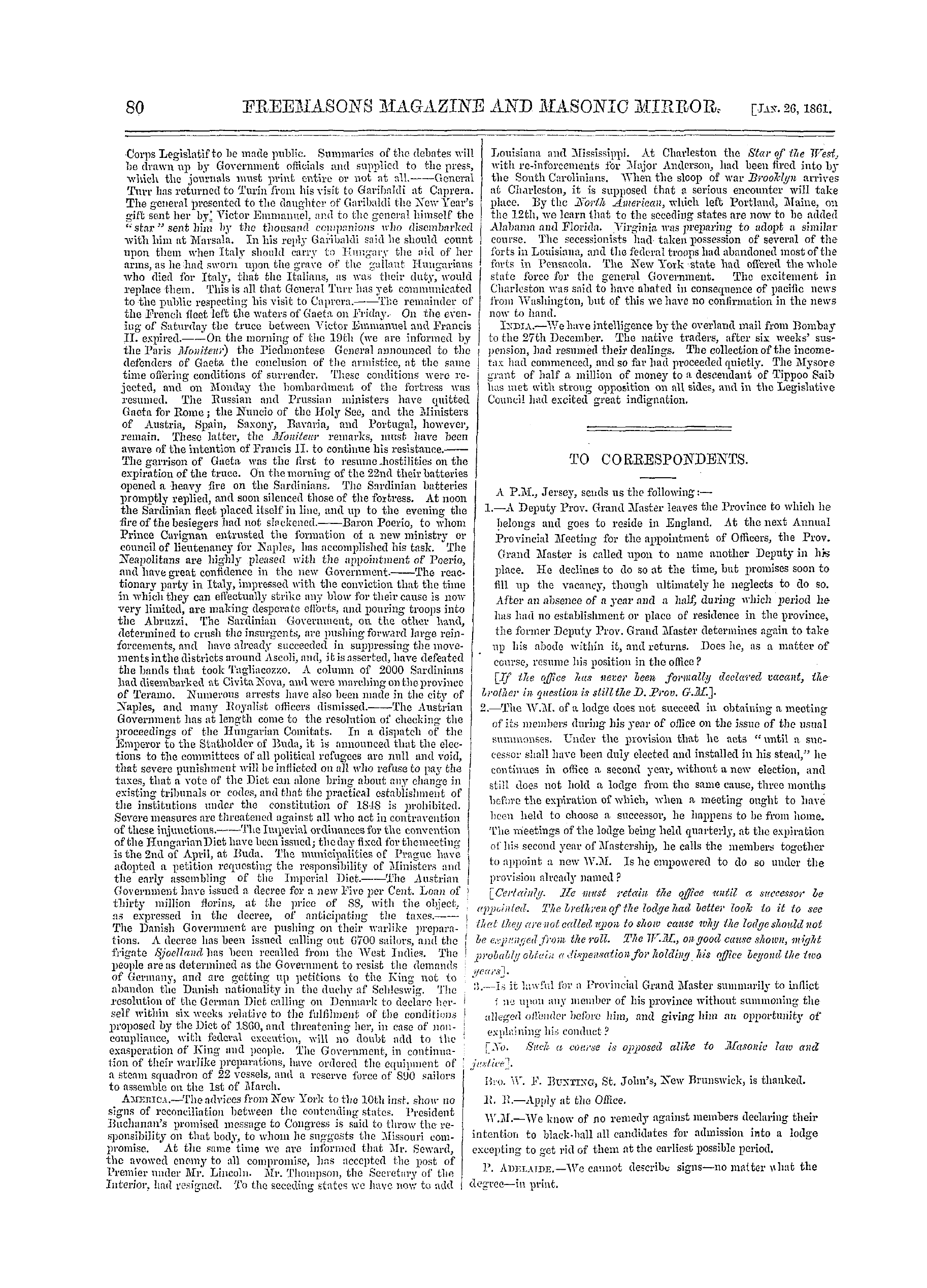-
Articles/Ads
Article ARCHITECTURE AND ARCHÆOLOGY. ← Page 2 of 2 Article ARCHITECTURE AND ARCHÆOLOGY. Page 2 of 2 Article THE TEMPERATE HOUSE, ROYAL BOTANIC GARDENS, KEW. Page 1 of 3 →
Note: This text has been automatically extracted via Optical Character Recognition (OCR) software.
Architecture And Archæology.
present ; what I do Avish is that she had more aim , more purpose , to teach good wherever she has tho opportunity . KnoAvinn- full Avell that to teach she must interest at the same time , and that the public which passes ivith a hasty glance a figure which has cost months of labour , will turn to a o-roup or bas-relief , with some story in it , with a curiosity ancl wish to find out its meaning , and if its meaning bo both
easily read and yet deep , the attention will be fixed , and yet the moral ofthe story treasured up , though it will be visited again and again , because the visitor has a secret thought that he has not yet fully mastered the all that was meant to be taught ; so different parts of the lesson will be taught . Sculpture is to my mind , at present too high and too low either to interest or to teach to its fullest power—ayeand a
, power great and beautiful . No human mind can knoiv , not knoAving the human heart , how great a poiver is trusted to man when gifts in art are given ; it is a poAver that makes every professor of the art deeply responsible for his gift , and for the manner in which he uses it .
Is it nothing , my brother artists , Avhether you put into a form of almost indestructible marble or bronze a meaning and thoughts' capable of ennobling or not the minds and thoughts of the many thousands who now look at it , pass on and to-morrow look again ? Thousands who are now too young to understand it , will look on it and talk about it , when they are grey-headed , and when those limbs , once
similar in roundness and beauty to those that you have modelled with so much care , refuse to do their accustomed work they will pass away , and children come again , grow old and die , and yet your statue will still raise its hands and teach ; is it nothing to you , its designer , what it says ? Shall it teach ri ght , or shall it teach wrong , or shall it idly teach nothing ? shall it teach consolation to the
despairingper-, severance to the wavering ? shall it pourtray frivolity or purity ? Shall it put before the aspiring mechanic , G-eorge Stephenson , the never tired , the always Avorking ? Shall the expression chosen be that most calculated for the classical effect and beauty of the statue , or for impressing the passers by and all who visit it ivith the peculiar character of the
man , so as to sink into the hearts of those that need it ? Shall the pedestal be merely beautiful , or merely massive , shall it contain nothing of his history , his struggles , his success , and that not merely because you know that such things belong to that statue , but to teach all that the associations of that man enable it to teach ? Can you not make it say , like Charles Mackay ' s verse ,
"Take courage you that wander bere , Lonely anil sad , and be of cbeer . This man that bad no aids to climb , But bis true heart ancl soul sublime , Lives in the annals of bis time ? "
Oh , the art in its variety , its numberless applications , may teach and cry aloud at every turning in the streets . Nothing past is forbidden to it , nothing present may not bo bent to it ; future aspirations withhi certain limits are open to it ; but , then , to do this , brother artists , yon must " stoop to conquer ; " stoop , did I say ; hardly is it stooping to do what Donatello , G-hiberti , andNicholo Pisano thought their proper
work Is it stooping to do what Michael Angelo did ? Is it stooping to do work with the same beauty of finish , but a higher aim , for the church door or pulpit , for the fountain or the market cross , or the niche or panel of a public building , as that which you do for the library or the ball-room ? And why must you do this ? because if you do not you will ever continue to have the same limited field of labour , the same limited opportunity of doing good with your art . Oh ! brother artist .
"Hast tliou in lands supremely blest , AVith thy refinements clone thy best To ease the ills tlion canst not cure To teach the wretched to endure , And shower thy blessings on tho poor ? " It may be doubtless said that patronage has the most to -no with thisbut if the aim of the art hiher and
; was g yet more universal and human in interest , patronage would grow , lor a larger class would be interested in it . I believe it is generall y admitted that the general public are now the best patrons of everything , whether of art , amusement , or
Architecture And Archæology.
instruction ; certainly municipalities , and boards , and associations , and subscription committees are not among the worst supporters of art of all kinds ; ivell , then , first teach , by exhibitions , the great things to be done by tbe association ofthe arts and you ivill soon have the © importunity of teaching greater things by your Avorks . Now-the lessons that I would teach by the proposed
Annual Exhibition are—1 . The many opportunities that architecture constantly giA'es for the embodiment and incorporation of first-class * sculpture . 2 . That sculptors of the A'ery highest rank should not think it beneath them to Avork on such associated sculpture . 3 . That sculptors may learn much from the study of
architecture and architectural carving , and may learn much that they UOAV lack , to enable them to work in harmony and unison Avith architecture , by seeing architectural caiwing and their OAVU figure sculpture placed side by side in the same room . 1 . That architectural art-workmen and carvers should have extended opportunities of studying , and seeing the
necessity of perfect figure sculpture , and have a goal more clearly shown to belong to their own art to strive to attain to . 5 . That architects should see architectural carving , and perfect sculpture combined , and therefore both wish to , and learn how best to make use of them in combination . 6 . That the public should see the two combined , and wish
to produce the utmost effects of the combination . My proposition , therefore , is that there should be an Annual Exhibition of all Sculpture at the Gallery at Conduit-street ; with , of course , the usual powers of selection and refusal , and that special invitation be given to—1 . All sculptors , viz ., such as usually exhibit at the Royal Academy . 2 . All professed architectural sculptors or carvers , and
other ornamental carvers . 3 . Architects to exhibit easts of sculpture or carving of all kinds executed , proposed , or about to be executed on the works ofthe year , or the works themselves if possible under circumstances where delay ia necessary , and therefore the Avork can be spared . I throw these few remarks to the public ear . More influential men may take them up . I trust they will : I am
sure that nothing but good would be produced . It surely needs little more from mo . It is not for me or any to prove to you how much progress is produced by showing annual progress—it is an established principle that few will deny that the founding of such an exhibition would conduce greatly to the tivofold object that I have in view in proposing it : a wider field for sculptors , and the consequent
increase ofthe glory of architecture , but let neither sculptor nor architect forget that the aim is still higher . We are deeply responsible , brother artists that read those columns , for our gifts ivhich are given to us for the teaching of men . —Correspondent of the Build-in /} Nines .
The Temperate House, Royal Botanic Gardens, Kew.
THE TEMPERATE HOUSE , ROYAL BOTANIC GARDENS , KEW .
Few of our national establishments possess greater interest than that of the Royal Botanic Gardens at Kew , whether viewed with reference to the increasing intelligence of the age or the more liberal policy Avhichhas characterised the Government of the last quarter of a century , aided by a Sovereign Avhose constant care has been in all things to increase the welfare and happmess of l : \ er people .
It is doubtful Avhether the ordinary visitor be aware of the true nature of tho institution , and of its importance and value to the State , be 3 'ond that of a place for the healthful recreation of the public . A brief retrospective glance at the history of the gardens , and a reference to the annual reports of the director , Sir W . J . Hookerunder whose skilful and intelligent
adminis-, tration thoy have reached their present excellence , ivill prove that the gratification of the public is not all that is aimed at ; but that science and commerce are largely benefited by this institution . Kew Gardens originated in the middle of the seventeenth
Note: This text has been automatically extracted via Optical Character Recognition (OCR) software.
Architecture And Archæology.
present ; what I do Avish is that she had more aim , more purpose , to teach good wherever she has tho opportunity . KnoAvinn- full Avell that to teach she must interest at the same time , and that the public which passes ivith a hasty glance a figure which has cost months of labour , will turn to a o-roup or bas-relief , with some story in it , with a curiosity ancl wish to find out its meaning , and if its meaning bo both
easily read and yet deep , the attention will be fixed , and yet the moral ofthe story treasured up , though it will be visited again and again , because the visitor has a secret thought that he has not yet fully mastered the all that was meant to be taught ; so different parts of the lesson will be taught . Sculpture is to my mind , at present too high and too low either to interest or to teach to its fullest power—ayeand a
, power great and beautiful . No human mind can knoiv , not knoAving the human heart , how great a poiver is trusted to man when gifts in art are given ; it is a poAver that makes every professor of the art deeply responsible for his gift , and for the manner in which he uses it .
Is it nothing , my brother artists , Avhether you put into a form of almost indestructible marble or bronze a meaning and thoughts' capable of ennobling or not the minds and thoughts of the many thousands who now look at it , pass on and to-morrow look again ? Thousands who are now too young to understand it , will look on it and talk about it , when they are grey-headed , and when those limbs , once
similar in roundness and beauty to those that you have modelled with so much care , refuse to do their accustomed work they will pass away , and children come again , grow old and die , and yet your statue will still raise its hands and teach ; is it nothing to you , its designer , what it says ? Shall it teach ri ght , or shall it teach wrong , or shall it idly teach nothing ? shall it teach consolation to the
despairingper-, severance to the wavering ? shall it pourtray frivolity or purity ? Shall it put before the aspiring mechanic , G-eorge Stephenson , the never tired , the always Avorking ? Shall the expression chosen be that most calculated for the classical effect and beauty of the statue , or for impressing the passers by and all who visit it ivith the peculiar character of the
man , so as to sink into the hearts of those that need it ? Shall the pedestal be merely beautiful , or merely massive , shall it contain nothing of his history , his struggles , his success , and that not merely because you know that such things belong to that statue , but to teach all that the associations of that man enable it to teach ? Can you not make it say , like Charles Mackay ' s verse ,
"Take courage you that wander bere , Lonely anil sad , and be of cbeer . This man that bad no aids to climb , But bis true heart ancl soul sublime , Lives in the annals of bis time ? "
Oh , the art in its variety , its numberless applications , may teach and cry aloud at every turning in the streets . Nothing past is forbidden to it , nothing present may not bo bent to it ; future aspirations withhi certain limits are open to it ; but , then , to do this , brother artists , yon must " stoop to conquer ; " stoop , did I say ; hardly is it stooping to do what Donatello , G-hiberti , andNicholo Pisano thought their proper
work Is it stooping to do what Michael Angelo did ? Is it stooping to do work with the same beauty of finish , but a higher aim , for the church door or pulpit , for the fountain or the market cross , or the niche or panel of a public building , as that which you do for the library or the ball-room ? And why must you do this ? because if you do not you will ever continue to have the same limited field of labour , the same limited opportunity of doing good with your art . Oh ! brother artist .
"Hast tliou in lands supremely blest , AVith thy refinements clone thy best To ease the ills tlion canst not cure To teach the wretched to endure , And shower thy blessings on tho poor ? " It may be doubtless said that patronage has the most to -no with thisbut if the aim of the art hiher and
; was g yet more universal and human in interest , patronage would grow , lor a larger class would be interested in it . I believe it is generall y admitted that the general public are now the best patrons of everything , whether of art , amusement , or
Architecture And Archæology.
instruction ; certainly municipalities , and boards , and associations , and subscription committees are not among the worst supporters of art of all kinds ; ivell , then , first teach , by exhibitions , the great things to be done by tbe association ofthe arts and you ivill soon have the © importunity of teaching greater things by your Avorks . Now-the lessons that I would teach by the proposed
Annual Exhibition are—1 . The many opportunities that architecture constantly giA'es for the embodiment and incorporation of first-class * sculpture . 2 . That sculptors of the A'ery highest rank should not think it beneath them to Avork on such associated sculpture . 3 . That sculptors may learn much from the study of
architecture and architectural carving , and may learn much that they UOAV lack , to enable them to work in harmony and unison Avith architecture , by seeing architectural caiwing and their OAVU figure sculpture placed side by side in the same room . 1 . That architectural art-workmen and carvers should have extended opportunities of studying , and seeing the
necessity of perfect figure sculpture , and have a goal more clearly shown to belong to their own art to strive to attain to . 5 . That architects should see architectural carving , and perfect sculpture combined , and therefore both wish to , and learn how best to make use of them in combination . 6 . That the public should see the two combined , and wish
to produce the utmost effects of the combination . My proposition , therefore , is that there should be an Annual Exhibition of all Sculpture at the Gallery at Conduit-street ; with , of course , the usual powers of selection and refusal , and that special invitation be given to—1 . All sculptors , viz ., such as usually exhibit at the Royal Academy . 2 . All professed architectural sculptors or carvers , and
other ornamental carvers . 3 . Architects to exhibit easts of sculpture or carving of all kinds executed , proposed , or about to be executed on the works ofthe year , or the works themselves if possible under circumstances where delay ia necessary , and therefore the Avork can be spared . I throw these few remarks to the public ear . More influential men may take them up . I trust they will : I am
sure that nothing but good would be produced . It surely needs little more from mo . It is not for me or any to prove to you how much progress is produced by showing annual progress—it is an established principle that few will deny that the founding of such an exhibition would conduce greatly to the tivofold object that I have in view in proposing it : a wider field for sculptors , and the consequent
increase ofthe glory of architecture , but let neither sculptor nor architect forget that the aim is still higher . We are deeply responsible , brother artists that read those columns , for our gifts ivhich are given to us for the teaching of men . —Correspondent of the Build-in /} Nines .
The Temperate House, Royal Botanic Gardens, Kew.
THE TEMPERATE HOUSE , ROYAL BOTANIC GARDENS , KEW .
Few of our national establishments possess greater interest than that of the Royal Botanic Gardens at Kew , whether viewed with reference to the increasing intelligence of the age or the more liberal policy Avhichhas characterised the Government of the last quarter of a century , aided by a Sovereign Avhose constant care has been in all things to increase the welfare and happmess of l : \ er people .
It is doubtful Avhether the ordinary visitor be aware of the true nature of tho institution , and of its importance and value to the State , be 3 'ond that of a place for the healthful recreation of the public . A brief retrospective glance at the history of the gardens , and a reference to the annual reports of the director , Sir W . J . Hookerunder whose skilful and intelligent
adminis-, tration thoy have reached their present excellence , ivill prove that the gratification of the public is not all that is aimed at ; but that science and commerce are largely benefited by this institution . Kew Gardens originated in the middle of the seventeenth
